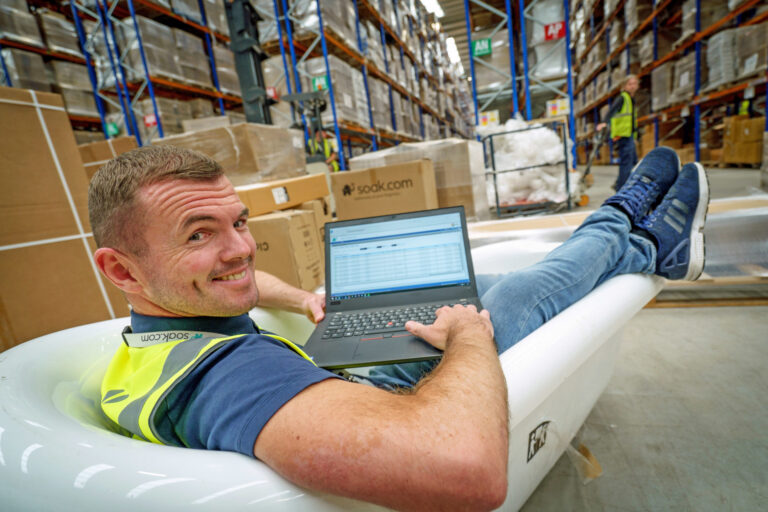The personalisation of e-commerce is putting even more pressure on the warehouse and supply chain, meaning that warehouse management systems will have to react. Is artificial intelligence the answer? Christopher Walton investigates…
If racking, shelving and forklifts are the muscles and bones of intralogistics then a good Warehouse Management System (WMS) is the nervous system. Without accurate instruction the constituent parts would not function.
But the building blocks in the warehouse are changing dramatically – automation, robots and cobots are changing materials handling, but so is the way that businesses engage with customers. Furthermore, when WMS was developed in the late 1990s and early 2000s it was a system to register stock; where it was in the warehouse and how it was delivered to customers. Now it is much more about optimising how the warehouse runs, managing people and equipment in the warehouse – as well as managing the stock.
Enterprise level businesses piled into WMS in the early 2000s, post dot-com boom when a huge amount of IT spending and investment was taking place. The problem is, some enterprise level businesses have not evolved their WMS since that point, so the systems are old. But the enterprise is so incredibly reliant on them that ripping them out and starting again is not an option.
Emile Naus, partner at BearingPoint, says that this is fundamentally a problem at vendor level, with some blue-chip IT companies treating WMS as a mature market, in much the same way that retail forecasting systems are treated. Yet for many logistics and supply chain operations they are in the infancy of their WMS adoption.
Up-front costs
The market innovation, argues Naus, is coming at an SME-level and through system integrators: “What we are seeing is a lot of smaller businesses affording to go for quite advanced systems on a pay-as-you-go basis. It has always been the upfront investment that has put vendors off.
“The counter effect with some of the larger businesses is that a change becomes really costly, we are seeing the reversal of the past when it was the big companies that would invest in IT, now some of the big companies are being held back by the architecture they have in place.”

Mark Wilkinson, supply chain consulting manager at WMS vendor Indigo Software, says market trends are very much going towards subscription-based pricing models. “Capex has always been an issue for SMEs, especially given all the uncertainty at the moment and it can be a factor in holding projects back,” he says.
“Moving WMS systems away from cap-ex and into op-ex budgets means the decision-making process can be shorter, there is often less of an authorisation approval process to consider and it becomes easier for clients to move forwards with projects. Indigo has responded to these changing customer expectations by offering a subscription-based pricing model for its WMS.”
Gavin Clark, senior vice-president for sales EMEA at Microlistics, agrees that the biggest barriers among SME’s is up-front cost and time-to-benefit: “Some vendors (including Microlistics) offer SME’s flexible deployment and payment options, including the option of regular monthly payments (without finance), in place of a large up-front cost.
“This agile approach allows for critical requirements to be delivered first, with phased optimisation to follow. This accelerates the customers return on investment.
“The most common mistake we see with WMS implementations is poor and rigid project specification. Thorough and flexible specification is essential to setting clear objectives and ensuring delivery teams have enough time to optimise process and operational flows, whilst understanding that business requirements can change.”
As well as controlling movements inside and out of the warehouse, the evolving WMS is allowing supply chain professionals to plan and procure better. Mel Tymm, industry principal at Maginus, explains that when WMS and the supply chain are fully integrated, trends in demand and fulfilment can be fed back from the WMS and analysed in real-time in the back-office system.
“This can then allow stock holding and stock requirement forecasts to be adjusted and monitored to ensure the right products are available for customer demand,” she says.
Forecast accuracy

“Advances in WMS systems and integrated back-office systems are allowing for push-pull inventory control systems, also known as lean inventory strategy. This strategy relies on accurate forecasts of sales and enables inventory levels to be adjusted based on actual sales and despatches of goods from the warehouse. The objective of lean inventory is to stabilise the supply chain and reduce the risk of products going out of stock, which can result in lost sales.”
Wilkinson at Indigo says that increased data accuracy is making forecasting and demand planning more efficient. He also says that warehouse managers can have full visibility of inventory storage locations either on or offsite, for instance, allowing products to be brought in on a just in time basis, so there is less need to stockpile (with events like Brexit being the exception). This also means, he says, having access to real-time stock figures, for procurement and demand planning.
“With paperless, fully integrated WMS systems becoming the new normal, purchasing teams and supply chains now have greater confidence in the quality and reliability of data being provided by the warehouse, so they can accept greater levels of automation in their forecasting systems. Greater reliability and ease of integration across the whole supply chain means forecasting and management decisions are much better informed,” he argues.
The Impact of Personalisation
Forecasting and procurement are now having to deal not just with seasonal or event-driven demands but with trends like personalisation – where an individual item is tailored to the desires of the customer.

Bearing Point’s Naus says: “If you do not keep up with the market, you very quickly go back if you are a big retailer. The market will shift and continue to shift, as it has always done, that is not a recent thing. Personalisation is critical because it is a way to tie you into a customer. The way to do that in a profitable way will tie you in as a retailer. Then you end up with a model like Nespresso have come up with. They like to sell coffee through all the channels but now they have a product they can sell direct to the consumer, at a better margin, and at a higher value at cost per gram, they have cut the middle man out and now introduced multiple products with more personalisation. It is quite an interesting model.”
Dealing with personalisation put even greater strain on any WMS says Clark at Microlistics: “Advanced systems can handle work orders and value-added services for personalised orders, without the need for increasing the SKU count, by utilising variables and order numbers as part of the order flow from pick to despatch,” he says.
“Without work order management within the WMS, this process is often carried out ‘off system’ which causes bottlenecks, requires manual processing and results in inefficient handling of orders,” Clark adds. “By removing these issues and providing real time visibility of goods ready to fulfil orders, enterprise warehouse management systems cater for make to order, seasonal and event driven peaks without the need to increase headcount, inventory or shipping costs.”
Wilkinson says many WMS systems have responded to personalisation with ‘value added services’ functionality, carefully controlling the process for personalisation: “This is equally common in e-commerce logistics, where different retailers want unique packaging for particular orders and manufacturers customise their shipments individually. Everything for the order from production to dispatch is carefully controlled, with the operator being guided through the value-add process by the WMS.
“Today, any brand engaging in e-commerce needs to have some level of value-added process capability and having the ability to enhance the algorithms and process capabilities, means they can thrive in an increasingly crowded market,” he adds.
Case study: Cleaning up the warehouse
Soak.com, a luxury bathroom products retailer, distributes through a number of B2C channels to the UK and Ireland but after acquiring a new, customised distribution centre in Liverpool it needed a digital solution which could easily be interfaced with its ERP system, implemented quickly, without a large capital investment and able to drive productivity improvements immediately.
SnapFulfil WMS gave Soak.com the competitive pricing and configuring flexibility it required to facilitate growth and reduce operating costs. Return on investment has already seen a 30 per cent reduction in operating costs from digital over paper management, with the cost per item now under 50p – a significant saving.
Additionally, Soak.com was able to fit out the purpose-built warehouse and secure all the necessary IT infrastructure and workforce to launch the SnapFulfil WMS across all its trading channels in just over three months.
Mike Wood, programme manager at Soak.com, said: “We spent a lot of time upfront defining our requirements and how SnapFulfil would integrate with our ERP order management system, so implementation has gone well – with the majority of our key milestones achieved and with no unexpected time or cost overruns. The SnapFulfil team were great on initial delivery and have maintained that level of quality service with their
after sales support.“We’ve quickly gained more insights into the efficiencies of our business management processes and have been able to react and improve accordingly because SnapFulfil records everything. Stock checks are 99.99 per cent accurate, which has been verified by external practitioners, and the precision of our reporting has been equally impressive.
“We’ve also been able to do enhancement and optimisation work as additional delivery carriers come on board and working closely with the SnapFulfil Continuous Improvement Team means more management data, better understanding and a WMS that keeps giving valuable insight.
“We use temporary order pickers to support peak trading and the system is simple and easy to use as well – in just a couple of hours they can be up-and-running on SnapFulfil – which really helps with our demand peaks.”
Closing the original Nuneaton warehouse – where Soak.com has its HQ – has been a major digital transformation, but the retailer now exceeds 14,000 pallets (previously 12,000) and a catalogue of up to 8,000 SKUs as part of a flourishing business.
By the end of summer 2019 the Liverpool site had taken up all of Nuneaton’s previous operational capacity.
Artificial Intelligence and Robotics
As consumer preferences evolve, so does technology, an artificial intelligence (AI) will be critical for order fulfilment says Clark: “A great example of this is via robotic aided picking, sorting and movement of inventory for much faster order picking and despatch.
“A WMS that can oversee these solutions, consolidating the data from multiple AI and automation providers into a single view of the warehouse operation, will enable businesses to understand product flow with a far greater granularity than they have ever before,” he says. “Algorithmic analysis of this data will provide important insights to users, but more importantly, will enable artificial intelligence to make rapid decisions effecting ordering, stock placement and fulfilment across the supply chain.”
Tymm says that across the entire supply chain information is captured, advances in AI mean that this information can be linked intelligently, resulting in increased efficiencies throughout the whole process.
“Data is collected and analysed on an hourly, daily, weekly and monthly basis in the back-office and WMS systems. AI can transform this data into trends and future predictions which can be used to create more accurate forecasts based on changing customer buying behaviours,” she says.
“This allows for external factors, such as planned marketing campaigns and current weather conditions to be factored in, thereby accurately predicting the probability of customer buying behaviour. The result of this is that businesses can ensure the right stock is available in the warehouse for current orders and that future predicted demand is forecasted more accurately. Meaning the stock you buy is the stock you need to fulfil customers’ orders.”
All of this means that the next generation of WMS will be even more sophisticated, as supply chains become slicker. A WMS that controls robots performing to pre-set schedules? Not beyond the realms of impossibility says Indigo’s Wilkinson.
“WMS systems are now mobile first and have touch screen functionality and very intuitive interfaces, just like consumer applications,” he says. “As requirements continue to become more precise, we envisage systems becoming more modular to fill any existing functionality gaps and users wanting to purchase set packages for their exact needs rather than invest in a complete system.”
The next generation of WMS
To this end Wilkinson argues that machine learning will become an important part of next generation WMS, allowing the WMS to learn for itself and automatically change algorithms to improve processes without the need for human intervention.
Clark says that the industry will continue to see WMS integrate with more platforms and hardware devices, at a deeper level, than we have to date. This, he says, will flow up and down the supply chain to manage activity from the manufacturing floor through to pricing and delivery.
“Personalisation options will become the new norm as retailers compete for customers. There will be more cross collaboration between retailers and suppliers and greater pressure to maximise asset utilisation. This means WMS will need to better connect with third party solutions and allow for more agile and flexible deployments,” he says. “Greater focus on actual cost-to-service will be critical as supply chain service providers look for different ways to service customers.”
![]() You can see plenty of WMS vendors at Intralogistics 2020, which takes place at the Ricoh Arena on 31 March and 1 April. Register your interest now at www.intralogistex.co.uk
You can see plenty of WMS vendors at Intralogistics 2020, which takes place at the Ricoh Arena on 31 March and 1 April. Register your interest now at www.intralogistex.co.uk







